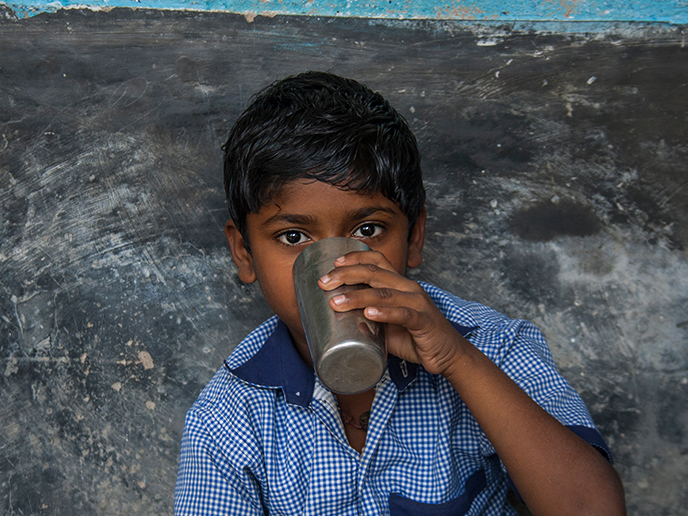Nature-based treatment of brackish groundwater in India
Over 2 billion people still lack safely managed drinking water(opens in new window). The arid Indian state of Gujarat suffers acute water scarcity, with limited surface water and increasingly saline groundwater due to abstraction activities and rising sea levels. Desalination technology could remove salt from these ground sources, but existing processes are energy-intensive, costly and environmentally damaging. In response, INDIA-H2O(opens in new window) has developed a promising nature-inspired water treatment system, powered by renewable energy. The project is co-funded by the EU and India’s Department of Science and Technology(opens in new window). “Our water purification technology, known as hybrid-batch reverse osmosis, benefits from low energy consumption while converting 95 % of contaminated water into clean water,” says Philip Davies, professor of Water Technology at the University of Birmingham(opens in new window) and INDIA-H2O project coordinator.
Technologies that mimic nature
Osmosis is a natural process in which water molecules cross a semipermeable membrane, and can be seen in how water molecules travel into and out of plant and animal cells. Crucially, these membranes act as a barrier to other molecules and particles (solutes) in the water. INDIA-H2O explored hybrid forward and reverse osmosis water treatment(opens in new window) based on biomimetic membrane technology, which embeds novel biological proteins to transport clean water across the membrane. Forward osmosis mimics how water is drawn into cells; reverse osmosis uses pressure to force the water through. INDIA-H2O’s reverse osmosis approach, uniquely configured to recycle the energy used to pressurise the water, can remove almost all the salt from water without discharging large volumes of liquid waste, which is usually the case with other desalination techniques. “The pressure required usually needs at least 1 kWh of electricity for 1 000 litres of drinking water,” notes Davies. “Our design, which features a pressure exchanging piston(opens in new window), halves this.” INDIA-H2O’s solution can also remove emerging pollutants (such as agricultural chemicals), as well as recover high-value waste water reagents generated by industrial processes, such as textile dyes. Additionally, the potential to operate these water treatment processes intermittently makes renewable energy ideal as a power source. “As well as being arid, Gujarat is sunny, making solar energy an obvious choice,” says Anurag Mudgal, from Pandit Deendayal Energy University(opens in new window) (PDEU) in Gandhinagar, Gujarat. “The system’s compact design makes it suitable for rural communities whose livelihoods are threatened by climate change.”
It takes a village
INDIA-H2O’s approach is now being piloted in the Guajarati village of Lodhva, where it is currently producing around 800 litres of clean water per hour. The technology has been installed in a local school to provide all its drinking water, and at PDEU to pilot the small-scale extraction of safe drinking water from brackish groundwater. “We are especially excited about developing these rurally relevant systems. They can produce seven to 10 cubic metres of safe drinking water a day using only solar power, or up to 20 using the grid. Costing less than 30 rupees per cubic metre, about EUR 0.35 they offer a real lifeline to communities,” adds Mudgal. The plan is to extend the capability of these village systems to include the recovery of clean water from rural domestic waste water. To showcase the circular economy potential of the approach, INDIA-H2O is also trialling the cultivation of Salicornia, a salt-tolerant edible crop, using the brine by-product of the desalination process. Routes to market are currently being explored, alongside community funding for more installations, to provide the village with a new income stream. Ensuring the sustainability and scalability of these demonstration systems locally, their design has been shared with Indian fabricators, along with a supply of the specialised membranes.
Building an enabling environment
In 2022, a Centre of Excellence in Water Treatment and Management(opens in new window) was opened at PDEU, offering state-of-the-art facilities to test water treatment solutions. Additionally, after two successful international water management conferences held at PDEU, a third is planned for 2024. The University of Birmingham has granted a licence for the hybrid batch reverse osmosis technology to spin-out company Salinity Solutions(opens in new window), raising over EUR 1.4 million, and has already reached agreement with British firm Te-Tech Process Solutions(opens in new window) to start production of bespoke water treatment solutions. Meanwhile project partners are also busy exploiting the technology. The Indian Central Electronics Engineering Research Institute(opens in new window) is currently commercialising sensor and monitoring technologies developed during the project. Aquaporin(opens in new window) in Denmark, developer of the forward osmosis biomimetic membrane technology, has been listed on the Nasdaq Copenhagen, raising EUR 38 million.







